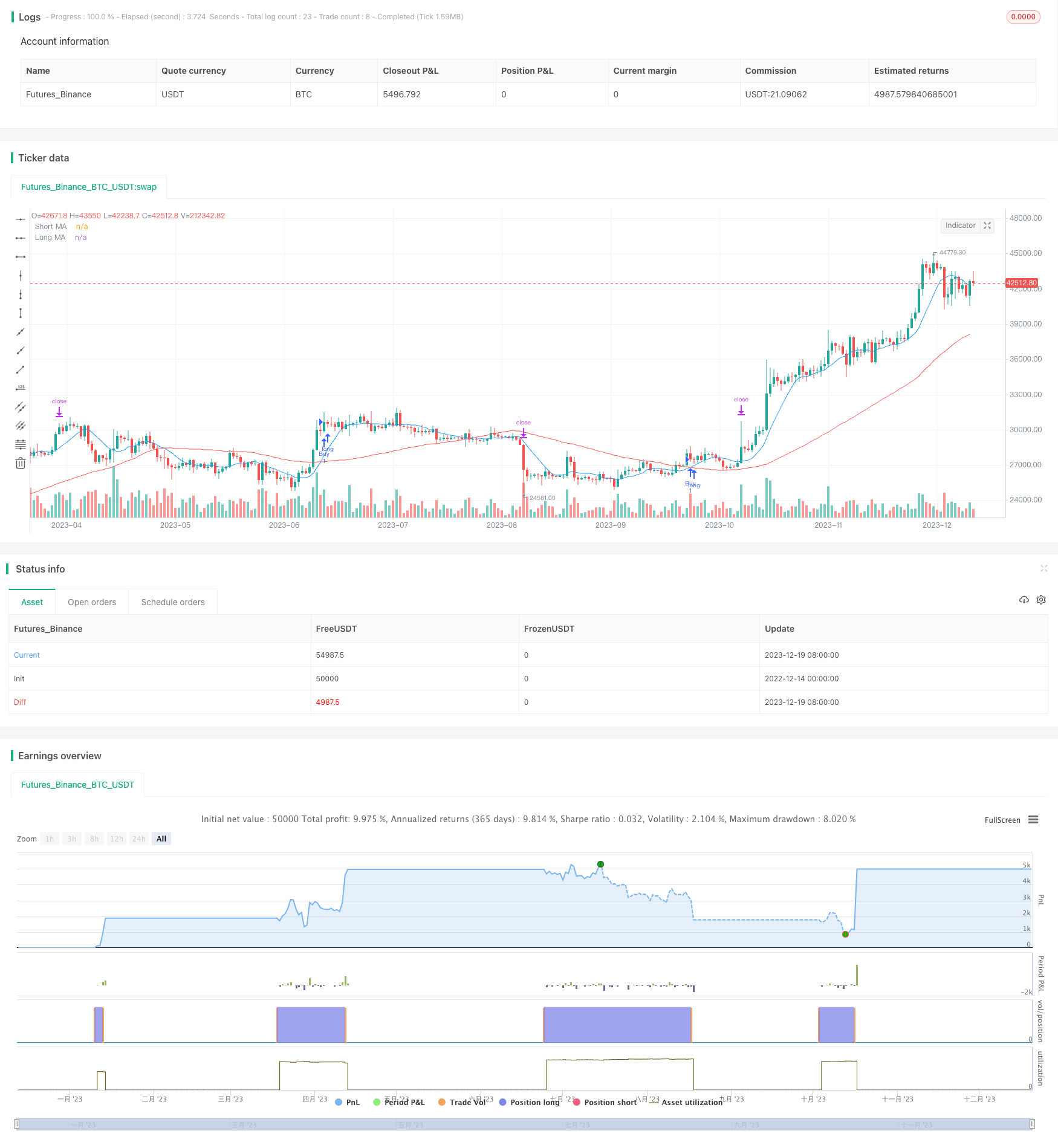
概述
该策略通过计算不同周期的移动平均线,设定止损止盈点,实现自动交易。当短周期移动平均线上穿长周期移动平均线时做多;当短周期移动平均线下穿长周期移动平均线时做空。同时设置止损和止盈点来控制风险。
策略原理
该策略基于均线交叉原理。它同时计算9日简单移动平均线和55日简单移动平均线。当9日均线上穿55日均线时,代表短期趋势反转为上涨,此时做多;当9日均线下穿55日均线时,代表短期趋势反转为下跌,此时做空。
同时,该策略利用ATR指标设置止损和止盈点。ATR指标可以衡量市场波动幅度。止损点设置为收盘价减去ATR值,这样可以根据市场波动性来設置合理的止损;止盈点利用风险回报比例来设定,这里设置为风险回报比例为2,即止盈 = 收盘价 + 2 * ATR值。
策略优势
这是一个非常简单实用的短线交易策略,有以下几个优势:
- 均线交叉原理简单易懂,容易掌握;
- 同时结合止损和止盈,可以有效控制风险,增强实用性;
- 移动平均线参数可以灵活调整,适应不同市场环境;
- ATR止损可以根据市场波动性设定止损点,比较智能;
- 风险回报比例设置可以根据个人风险偏好调整。
策略风险
该策略也存在一些风险:
- 均线交叉信号可能出现假突破,引发错误交易;
- 止损或止盈设置不当可能增大亏损或减小盈利;
- 移动平均线参数设置不当会导致交易频率过高或信号滞后;
- ATR参数设置不当也会使止损点过近或过远。
对于这些风险,可以通过优化参数、严格止损、合理位置管理来降低。
策略优化
该策略还可以进一步优化:
- 利用优化工具寻找最佳移动平均参数组合;
- 增加其他指标过滤均线交叉信号,避免假突破;
- 尝试其他类型的移动平均线,如指数移动平均线等;
- 可以考虑将ATR参数也加入优化,使止损止盈更加智能。
总结
该策略整体思路清晰、易于实现,特别适合初学者掌握。作为一个基础的短线交易策略,它具有操作简单、容易优化等优点。如果搭配COMPLETE或其他框架使用,可以进一步强化该策略,使之成为一个足够实用的量化交易系统。
策略源码
/*backtest
start: 2022-12-14 00:00:00
end: 2023-12-20 00:00:00
period: 1d
basePeriod: 1h
exchanges: [{"eid":"Futures_Binance","currency":"BTC_USDT"}]
*/
//@version=5
strategy("MA Crossover Strategy with Stop-Loss and Take-Profit", overlay=true)
// Input for selecting the length of the moving averages
maShortLength = input(9, title="Short MA Length")
maLongLength = input(55, title="Long MA Length")
// Input for setting the risk-reward ratio
riskRewardRatio = input(2, title="Risk-Reward Ratio")
// Calculate moving averages
maShort = ta.sma(close, maShortLength)
maLong = ta.sma(close, maLongLength)
// Buy condition: 9-period MA crosses above 55-period MA
buyCondition = ta.crossover(maShort, maLong)
// Sell condition: 9-period MA crosses below 55-period MA
sellCondition = ta.crossunder(maShort, maLong)
// Set stop-loss and take-profit levels
atrValue = ta.atr(14)
stopLossLevel = close - atrValue // Use ATR for stop-loss (adjust as needed)
takeProfitLevel = close + riskRewardRatio * atrValue // Risk-reward ratio of 1:2
// Execute buy and sell orders with stop-loss and take-profit
strategy.entry("Buy", strategy.long, when = buyCondition)
strategy.exit("Sell", from_entry="Buy", loss=stopLossLevel, profit=takeProfitLevel)
// Plot moving averages on the chart
plot(maShort, color=color.blue, title="Short MA")
plot(maLong, color=color.red, title="Long MA")